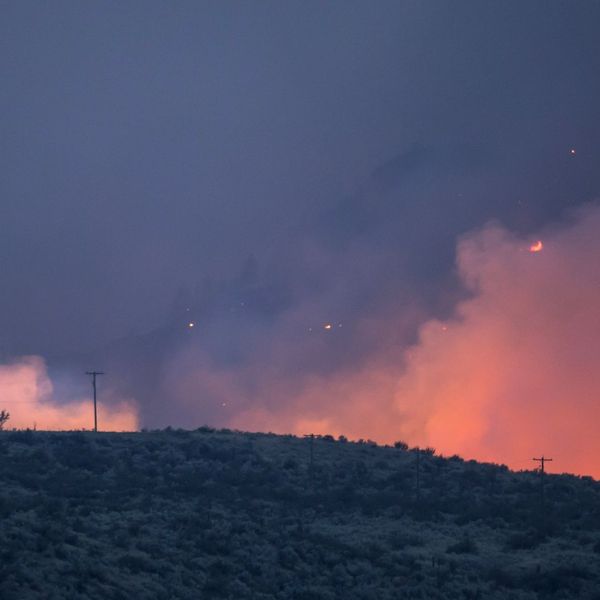Insurance Industry: It's Time to Start Calculating Cost of Climate 'Catastrophe'
Out to protect their bottom-line, Lloyd's of London urges insurers to account for future global warming disaster
Insurance industry leaders have declared it is now clear that insurers must begin formally including climate change in their calculation of future catastrophes to protect to protect their bottom-lines.
In a 41-page report released Thursday, Lloyd's of London--the oldest and largest insurance market in the world--warns, "Scientific research points conclusively to the existence of climate change driven by human activity," and therefore global warming must be included in "catastrophe modeling tools" moving forward.
Insurers must account for a whole host of problems, including rising sea levels, which can lead to severe "weather events" such as Superstorm Sandy.
"The approximately 20 centimeters of sea-level rise at the southern tip of Manhattan Island increased Superstorm Sandy's surge losses by 30% in New York alone," reads the report. "Further increases in sea-level in this region may non-linearly increase the loss potential from similar storms. Catastrophe models that dynamically model surge based on current mean sea-level already factor this increased risk into their projections."
Failure to conform with the changing reality will be, well, expensive. "2011 is regarded as a record year for natural catastrophe, with insured losses costing the industry more than $127 billion," warns the report.
Catastrophe modeling, a relatively young process, can "help companies anticipate the likelihood and severity of potential future catastrophes before they occur so that they can adequately prepare for their financial impact," urges the report.
What the study does not clarify is who will bear the burden of paying for the human tragedies to come.
_____________________
An Urgent Message From Our Co-Founder
Dear Common Dreams reader, The U.S. is on a fast track to authoritarianism like nothing I've ever seen. Meanwhile, corporate news outlets are utterly capitulating to Trump, twisting their coverage to avoid drawing his ire while lining up to stuff cash in his pockets. That's why I believe that Common Dreams is doing the best and most consequential reporting that we've ever done. Our small but mighty team is a progressive reporting powerhouse, covering the news every day that the corporate media never will. Our mission has always been simple: To inform. To inspire. And to ignite change for the common good. Now here's the key piece that I want all our readers to understand: None of this would be possible without your financial support. That's not just some fundraising cliche. It's the absolute and literal truth. We don't accept corporate advertising and never will. We don't have a paywall because we don't think people should be blocked from critical news based on their ability to pay. Everything we do is funded by the donations of readers like you. Will you donate now to help power the nonprofit, independent reporting of Common Dreams? Thank you for being a vital member of our community. Together, we can keep independent journalism alive when it’s needed most. - Craig Brown, Co-founder |
Insurance industry leaders have declared it is now clear that insurers must begin formally including climate change in their calculation of future catastrophes to protect to protect their bottom-lines.
In a 41-page report released Thursday, Lloyd's of London--the oldest and largest insurance market in the world--warns, "Scientific research points conclusively to the existence of climate change driven by human activity," and therefore global warming must be included in "catastrophe modeling tools" moving forward.
Insurers must account for a whole host of problems, including rising sea levels, which can lead to severe "weather events" such as Superstorm Sandy.
"The approximately 20 centimeters of sea-level rise at the southern tip of Manhattan Island increased Superstorm Sandy's surge losses by 30% in New York alone," reads the report. "Further increases in sea-level in this region may non-linearly increase the loss potential from similar storms. Catastrophe models that dynamically model surge based on current mean sea-level already factor this increased risk into their projections."
Failure to conform with the changing reality will be, well, expensive. "2011 is regarded as a record year for natural catastrophe, with insured losses costing the industry more than $127 billion," warns the report.
Catastrophe modeling, a relatively young process, can "help companies anticipate the likelihood and severity of potential future catastrophes before they occur so that they can adequately prepare for their financial impact," urges the report.
What the study does not clarify is who will bear the burden of paying for the human tragedies to come.
_____________________
Insurance industry leaders have declared it is now clear that insurers must begin formally including climate change in their calculation of future catastrophes to protect to protect their bottom-lines.
In a 41-page report released Thursday, Lloyd's of London--the oldest and largest insurance market in the world--warns, "Scientific research points conclusively to the existence of climate change driven by human activity," and therefore global warming must be included in "catastrophe modeling tools" moving forward.
Insurers must account for a whole host of problems, including rising sea levels, which can lead to severe "weather events" such as Superstorm Sandy.
"The approximately 20 centimeters of sea-level rise at the southern tip of Manhattan Island increased Superstorm Sandy's surge losses by 30% in New York alone," reads the report. "Further increases in sea-level in this region may non-linearly increase the loss potential from similar storms. Catastrophe models that dynamically model surge based on current mean sea-level already factor this increased risk into their projections."
Failure to conform with the changing reality will be, well, expensive. "2011 is regarded as a record year for natural catastrophe, with insured losses costing the industry more than $127 billion," warns the report.
Catastrophe modeling, a relatively young process, can "help companies anticipate the likelihood and severity of potential future catastrophes before they occur so that they can adequately prepare for their financial impact," urges the report.
What the study does not clarify is who will bear the burden of paying for the human tragedies to come.
_____________________

